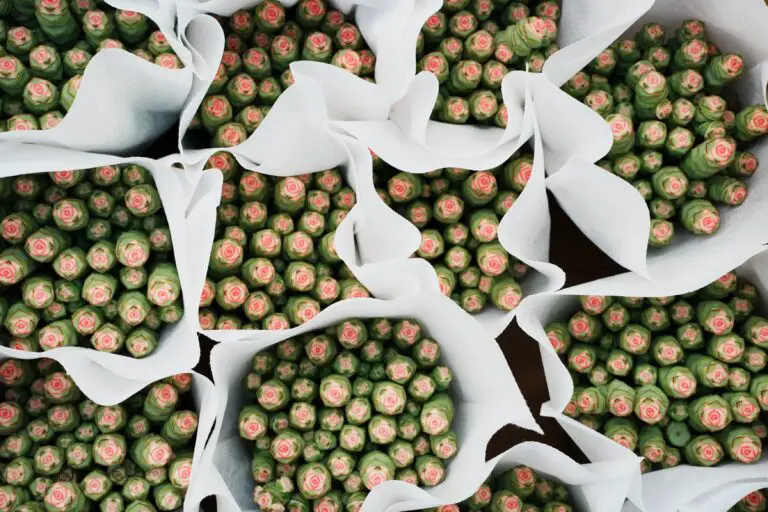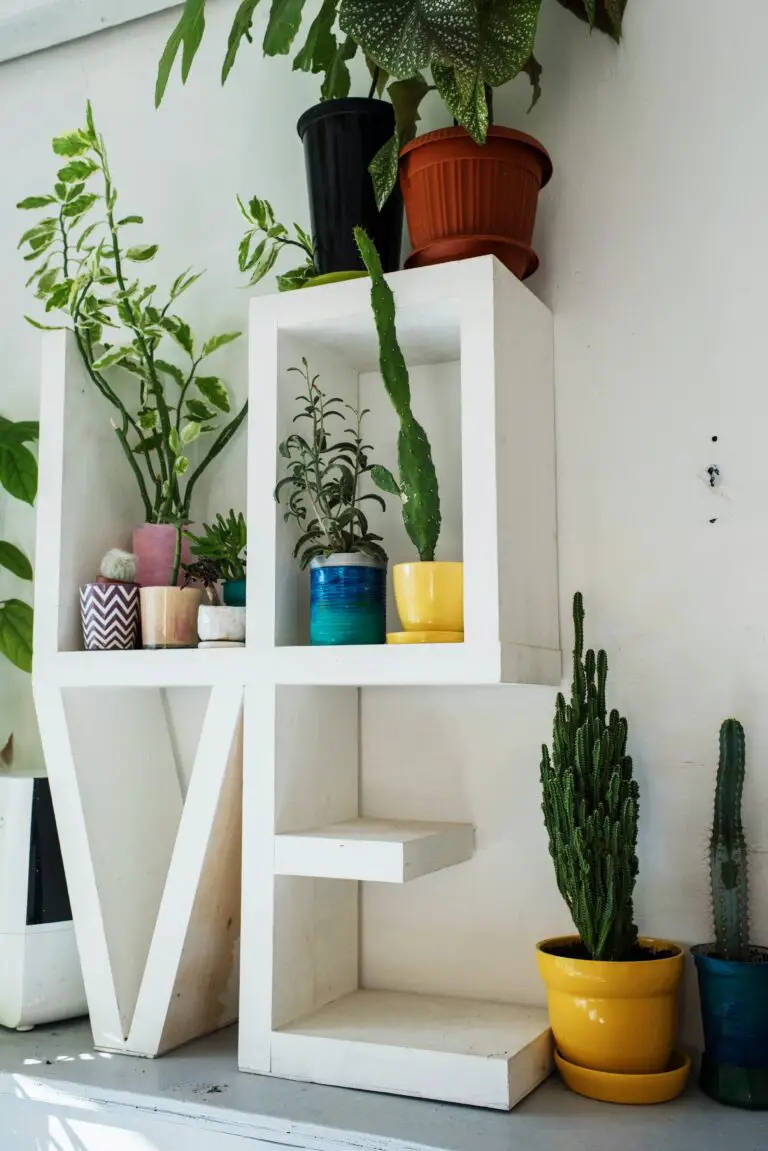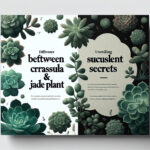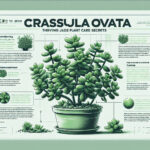Introduction to the World of Crassula and Jade Plants
Welcome to the lush, thriving universe of succulents where the Crassula genus reigns supreme with its illustrious member—the beloved Jade plant. Often found perched on sunny windowsills or gracing office desks, the Jade plant, also known scientifically as Crassula ovata, has nestled itself comfortably into our lives and homes. But hold on, is every Crassula we come across actually a Jade plant, or have we all been under a green thumb delusion? Let’s debunk some myths and clear the air once and for all.
Picture this: A friend has just boasted about their “Jade plant” collection, only to reveal a motley crew of assorted Crassula species. You might scratch your head thinking, “Aren’t they all the same thing?” The answer might surprise you. Despite their familial ties, not all Crassulas can claim the Jade plant title. That’s a crown reserved for Crassula ovata—renowned for its fleshy, glossy leaves that whisper tales of prosperity and good fortune.
Now, don’t get me wrong. There are imposters among us! A variety of Crassula species masquerade with similar attributes, but only the true Jade plant can carry the torch of opulence and resilience that legends speak of. This particular succulent is a hardy soul, able to withstand the test of time and the occasional forgetful waterer. To unearth more about these fascinating plants and their care, sneak a peek at this insightful guide, which dives into the nuances between Crassula and Jade plants.
In our journey to explore the vast Crassula genus, let’s not forget to greet other members like Crassula arborescens or Crassula muscosa, each with their quirky charms. But amidst the crowded green scene, the true Jade plant—Crassula ovata—stands out. It’s like running into an old friend in the busiest of marketplaces; a friendly, familiar face among many exciting strangers.
So, next time you hear someone toss around the term “Jade plant,” take a moment to investigate. Is it the storied Crassula ovata with a lineage of luck and longevity, or another intriguing species adding depth and diversity to the Crassula lineage? Keep your eyes peeled and your succulent savvy sharp. The world of Crassula and Jade plants is vast and vibrant, and certainly deserves a moment in the horticultural spotlight.
Discovering the Crassula Genus: A Botanical Overview
Welcome to the enchanting world of Crassula, a diverse and fascinating genus that’s often associated with the well-known Jade Plant. But hold on! Before you think you’ve got these succulent gems all figured out, let’s dive into what makes Crassula a true botanical treasure. These plump-leaved beauties are far more than just your average houseplant; they’re a group of plants with a rich tapestry of forms, habits, and adaptations.

Characterized by their thick, fleshy leaves that store water, Crassula species come in sizes ranging from dainty miniatures to robust bushes. When peering closer into the lush foliage of Crassulas, one can’t help but admire their geometric precision. The leaves are often arranged in striking symmetrical sequences that captivate onlookers and enthusiasts alike.
Found mainly in the Eastern Cape of South Africa, the species within the Crassula family showcase an awe-inspiring versatility. Whether thriving in rugged landscapes or gracing our homes with their presence, these succulents have adapted to both feast and famine in terms of water availability—speaking testament to their resilience and tenacity.
Did you know that Crassula can proudly boast more than just aesthetic appeal? These hardy succulents also stand strong as low-maintenance options for both seasoned and novice gardeners alike. Caring for a Crassula is an excellent starting point for those stepping into the world of succulent cultivation, and you can learn more about succulent care from our guide.
Among the numerous varieties, Crassula ovata, the Jade Plant, is the superstar—a symbol of good luck and a fixture in homes worldwide. But beyond the celebrated jade, lies a galaxy of other species, each with its own unique story and ornamental charm.
Crassulas are more than just a plant; they’re living sculptures. From the pillar-like Crassula ‘Buddha’s Temple’ to the cascading ‘String of Buttons’, there’s a fit for every plant lover’s desire. And, excitingly enough, enthusiasts keep unearthing new varieties, expanding our understanding and appreciation of this versatile genus. If you’re curious to delve deeper into the Crassula’s capabilities and characteristics, here’s an insightful read that sheds light on these succulent sensations.
As we observe these plants’ play of shadow and light, canopy of color, and rhythm of growth, we come to realize that each Crassula tells its own vivid tale. They invite us to pause and appreciate the subtle, often overlooked intricacies of nature. Discovering the Crassula genus is not just a botanic exploration—it’s a journey into a world of living artistry that has much to teach us about resilience, beauty, and the fascinating complexity of life.
The Jade Plant: A Crassula Species or A Class of Its Own?
When you think of a Jade plant, the image that typically springs to mind is that of Crassula ovata, a lush green succulent with a woody stem and glossy, plump leaves. It’s a plant that’s gained fame not just for its ease of care but also for being a symbol of prosperity. But is Crassula ovata, the species we commonly acclaim as the Jade plant, the be-all and end-all of the Crassula genus? Let’s explore this question with the expertise of a plant detective!
Imagine walking through an avid gardener’s home, where every corner you turn, there’s a different variety of Crassula catching your gaze. You might spot the ‘Gollum’ with its uniquely shaped leaves reminiscent of small green horns or the ‘Hobbit’ with its leaf-tips turned outwards like a choir singing to the sun. These are not just aesthetic whimsies of nature; these features mark a distinction within the vast Crassula family, each with its particular charm and care requirements more suited to its structure and native habitat.
This botanical journey takes an intriguing twist when we consider the difference between Crassula and Jade plants. While all thumbs are fingers, not all fingers are thumbs; similarly, while all Jade plants are Crassulas, not all Crassulas are Jade plants. This analogy helps us appreciate the diversity present within the genus Crassula, a genus comprising over 200 species that come in various shapes, sizes, and even colors.
To the untrained eye, many Crassulas could masquerade as the classic Jade plant, but upon closer inspection, their unique identities shine through. The classic Crassula ovata boasts a robust and tree-like growth pattern, making it a popular choice for bonsai enthusiasts looking to cultivate a miniature tree. Its resilience against drought and its forgiving nature when it comes to watering mistakes stem from its ability to store water within its leaves – a true survivor of the plant kingdom.

While some Crassulas flaunt their ability to flower, with modest inflorescences that can vary from white to pink, the Crassula ovata also blooms under the right conditions, adding a delicate touch to its already impressive repertoire. It’s these subtle nuances that make the discernment between Crassula species so fascinating and essential for the well-informed plant enthusiast.
So, is Crassula a Jade plant? In essence, yes, but it’s just one representative – the poster child, if you will – of a wider and wondrous variety of succulents that all share the Crassula family name. Just as different dog breeds can differ vastly while all being Canis lupus familiaris, the Crassula varieties demonstrate that diversity is the spice of life, especially in the succulent world.
Cultivating Your Green Thumb: Crassula & Jade Plant Care
Gardening enthusiasts, assemble! If the idea of transforming your living space into a calming oasis with a touch of verdant flair sounds thrilling, then you’re in for a treat. Let’s talk about elevating Crassula and Jade plant parenting to an art form. We’re not just growing plants; we’re curating a vibrant, living gallery at home!
First things first, let’s demystify the often-interchanged terms—Crassula and Jade Plants. While Crassula is a broad genus of plants, the name ‘Jade Plant’ typically refers to the star of the show, Crassula ovata. These succulent beauties share a lot in common, but remember, every plant has its own personality and will thrive with the right approach. So roll up your sleeves, because it’s time to get hands-on with some botanical styling and care!
Location, Location, Location: These plants love the limelight, literally. A sunny window ledge or any spot that bathes them in bright, indirect sunlight is ideal. Imagine your plant’s leaves reaching out for those warm rays, soaking up energy for lush growth, like a sunbather relishing the afternoon glow.
Watering Wisdom: Overzealous watering is a no-go for Crassula and Jade Plants. These drought-tolerant troopers prefer a ‘less is more’ approach. Think of a dessert after a satisfying meal—not too much, just enough to hit the spot. Wait for the soil to dry out before offering another drink. And when you water, be generous but not lavish—your plant’s roots should feel refreshed, not drenched.
Feeding Finesse: These plants aren’t finicky eaters, but they do appreciate a boost during their growth period. A balanced, water-soluble fertilizer, diluted to half-strength, is like a gourmet meal for them. Serve this up once a month during the spring and summer, and watch them flourish. Trust me, it’s like seeing a glow-up in slow motion!
Pruning Proficiency: Every now and then, these plants could use a trim, much like a visit to the barber for a fresh look. Snipping off any wayward branches not only keeps your Crassula or Jade looking sharp, but it also encourages denser growth. Have you ever seen a Jade plant shaped into a miniature tree? It’s the bonsai effect, and it’s absolutely enchanting.
By infusing these practices into your daily routine, you’ll turn your home into a green sanctuary. Real-life examples? Take Sarah, who transformed her dull apartment corner into a mini-jungle withCrassula varieties, or Mark, whose Jade plant centerpiece on the dining table has become a conversation starter at dinner parties. Be like Sarah and Mark—make each day a green-thumb adventure!
And to inspire your journey into the world of Crassula and Jade Plant care, feast your eyes on this:

Let these tips and best practices spark a green revolution in your home. Happy planting!
Propagation Perfection: Multiplying Your Jade Plant Collection
Calling all green thumbs and budding gardeners! If you’ve been charmed by the resilient beauty of a Jade plant, also known as the Crassula ovata, and are itching to create an entire collection from your beloved botanical specimen, you’re in luck. Let’s dive into the verdant world of propagating your Jade plants. Think of it as a botanical photocopy machine—but with leaves and stems instead of paper.
Step 1: Picking Your Plant’s “Photocopies”
Start your propagation journey by selecting healthy and robust leaves or stem cuttings from your existing plant. Just like choosing the ripest apple from the tree, look for parts of the plant that are plump and free from any blemishes. Think of it as the plant version of selecting the best candidates for a top job!
Step 2: The Waiting Game
Patience is a virtue, especially in the world of plant propagation. Once you’ve gently twisted your chosen leaf from the stem or snipped a segment with a sterilized pair of scissors, it’s time to let them dry. This step is crucial—think of it as allowing a good wine to breathe. Give the cuttings a few days to form a callous over the cut surface, preventing unwanted guests (like fungi) from crashing your plant’s growth party.
Step 3: Landing on the Right Soil
When the callous has formed, it’s time to introduce your little photocopied cuttings to their new home. A well-draining soil mix, the kind that would make even the most pretentious plant’s roots giddy with excitement, is your best bet. Nestle the cuttings into the soil and just lightly water them—imagine you’re seasoning a gourmet dish with a pinch of salt.
Step 4: A Spot in the Sun (Sort Of)
Like a sunbather finding that perfect spot on the beach, finding the right location for your propagating Jade plants is key. Bright, indirect light will coax your plant babies into flourishing without the intensity of a direct summer sun, which can be more like a scorching day in the Sahara for these tender cuttings.
Check out this informative video for a visual guide through the propagation process:
Common Do’s and Don’ts
Remember those do’s and don’ts we promised? Here are a few: DO be gentle with your cuttings, as they can be as delicate as a house of cards. DO maintain a consistent watering schedule—your plant isn’t out to survive a drought. And absolutely DO NOT overwater; this is not a swimming competition for the roots. Finally, DO NOT lose hope if some cuttings don’t make it—nature, as in life, isn’t a tale of 100% success.
As you embark on this enchanting journey of propagating your Jade plant, remember that each new sprout is a living testament to your gardening prowess. With each new leaf and stem, you’re not just growing plants; you’re cultivating patience, precision, and a bit of that proverbial green thumb magic. Happy planting!
The Aesthetics of Crassula: Decorative Uses in Home and Garden
Crassula plants, commonly known as Jade plants, are synonymous with grace and resilience, making them a beloved gem in home decor. Unearthing the beauty of these succulents and their role in aesthetic adornment can be both exciting and transformative to living spaces. Let’s delve into how to beautify your dwelling with these green treasures.
Much like a sculptor turns a block of stone into art, you can transform your home with strategically placed Crassula plants. These succulents aren’t just about greenery; they carry a substantial weight of style and symbolism. They are adored for their plump leaves, which symbolize growth and renewal, making them not just plants, but pieces of living art.
Imagine walking into a room where the corners are accentuated with lush Crassula grown in sleek geometric pots, creating a dialogue between the natural and the man-made. These succulents can adapt to a variety of container shapes and materials, thereby infusing a modern or rustic charm, reflecting your own personal aesthetic.
The versatility of Crassula plants means they seamlessly blend with diverse design themes—from minimalist to bohemian. A Jade plant poised on a floating shelf adds serenity to a space otherwise buzzing with activity. In a home office, a small Crassula beside your monitor can be a gentle reminder of the outside world, promoting a calming and productive environment.
Outdoor gardens too can reap the charismatic presence of these succulents. Nestled among rocks or standing solo in a statement planter, Crassula varieties elevate the beauty of your garden’s landscape. Not to mention, their drought-tolerant nature makes them eco-friendly, requiring less water and care while offering a lush aesthetic.
But don’t just take our word for it. Visually experience the elegance of decorating with Crassula plants through this video which showcases various ways you can incorporate them into your living space.
Whether as a centerpiece or a subtle green touch, understanding that Crassula is not just a Jade plant, but a versatile decor element, can revolutionize your interior and exterior design. It’s all about letting their quiet elegance speak volumes, creating a serene and visually appealing environment.
The personal touch is paramount. Customizing your Crassula arrangements to reflect your lifestyle and taste can transform your space into a reflection of your own version of paradise. Imagine a bespoke Crassula bonsai greeting guests at the entrance, a testament to your unique creativity and the timeless elegance that is the Jade plant.
Embracing the beauty of these succulents is akin to adopting a piece of nature’s soul into your home. It’s more than just decorating; it’s about creating a space where aesthetics and wellbeing walk hand in hand, nurtured by the gentle touch of Crassula’s jade-green leaves.
Crassula vs. Jade Plants: Understanding the Differences
Have you ever found yourself in a garden center, admiring the succulents and wondering if that gorgeous green buddy with the fleshy leaves is a Crassula or a Jade plant? Well, you’re not alone in this horticultural head-scratcher. These two plant types often cause a bit of confusion, but fear not—let’s dig into what sets them apart!
First off, let’s tackle the names. ‘Crassula’ is a genus within the succulent family, boasting an impressive array of species, which—plot twist—includes the famed Jade plant, scientifically named Crassula ovata. But hold on! Not all Crassulas are Jades, and not all Jades are Crassulas, even though the terms are sometimes used interchangeably. Think of it like squares and rectangles—while all squares are rectangles, not all rectangles are squares.
Popping over to the real-life example aisle, let’s say you’re visiting a friend who has a stunning collection of succulents. You spot a plant with glossy, oval leaves, and confidently announce, “That’s a Crassula!” only to learn it’s actually a Portulacaria afra, commonly known as “Dwarf Jade.” It’s a succulent that looks like a Jade plant but isn’t part of the Crassula genus at all. Who knew the plant world had such doppelgangers!
The true Jade plant, our Crassula ovata, often flaunts thicker, rounded leaves that resemble jade stones (hence the name). They get bonus points for being those luck-bringing, prosperity-promising plants you’ve probably heard about. Meanwhile, other Crassula species might have needle-like leaves or form tight rosettes. Their charm lies in diversity—ranging from ground-crawling cuties to towering tree-like structures.
So, to sum it up: while Jade plant is a celebrity within the Crassula family, it’s only one star among a constellation of Crassula species. Next time you find yourself in a greenery-filled rendezvous, impress your plant pals by dissecting the succulent scene with your newfound Crassula clarity!
The Symbolism and Mythology Surrounding Jade Plants
Delve into the enchanted world of Jade plants, where every glossy leaf and verdant stem whispers tales of prosperity and good fortune. The Crassula ovata, commonly referred to as the Jade plant, is more than just a pretty face in the world of horticulture. It’s laden with a treasure trove of cultural significance that spans the globe, imbuing it with a mystique that captivates the human spirit.

In the bustling streets of Hong Kong open-air markets, you’ll find these fleshy, emerald beauties nestled among stalls as charms to attract wealth. Business owners often place them at the entrance of their shops, an emblem to usher in financial success and ward off negative energies. Even within the cozy confines of a home, people regard the Jade plant as a living talisman, believed to amplify the flow of chi and brighten the aura of indoor spaces.
Move further east, and you’ll uncover that Jade plants hold a cherished spot in Feng Shui. The art of placement is meticulous and thoughtful, with practitioners positioning this succulent in the ‘wealth corner’ of homes. The glossy leaves – reflecting the color of jade stones known in Eastern traditions as symbols of virtue and purity – are thought to resonate with the very vibrations of prosperity.
But the allure of the Jade plant isn’t just confined to its purported monetary magnetism. In social lore, gifting a Jade plant is considered a token of goodwill. Whether it’s a housewarming or a token of appreciation, the act extends beyond the physical gesture; it’s an unspoken wish for good health, wealth, and enduring friendships.
During festive celebrations, like the Lunar New Year, Jade plants become emblematic centerpieces. Their dense clusters of leaves are likened to jade coins, lending a visual mantra of wealth accumulation. It’s not uncommon to find families nurturing aged Jade plants, passed down through generations, each layer of leaves carrying the collective aspirations and memories of loved ones.
Every culture adds a stitch to the rich tapestry of symbolism that the Jade plant embodies. From the proverbial ‘money plant’ in the West, signifying financial growth and stability, to the enduring symbol of grace and positive energy in the East, Crassula varieties are not just simple houseplants. They narrate an age-old tale where nature intersects with human belief, dreaming a lush dream of good omens and prosperity.
Frequently Asked Questions (FAQs)
Ever found yourself wondering if the glossy green plant gracing your windowsill is a Crassula or a Jade plant? Or perhaps you’ve received gardening advice for one, but you’re not sure if it applies to the other? You’re not alone! Welcome to the FAQs section, where we dive into the nuances between Crassula and Jade plants, and shed some light on this green conundrum.
Think of Crassula as a grand family name, a sprawling clan of succulents that includes the star of our show, the Jade plant. But not all Crassulas are Jades, much like not all Fords are Mustangs. Both the Crassula and the Jade plant enjoy the sunny ledges of homes worldwide, their fleshy, vibrant leaves storing water to help them thrive even when you’re too busy to tend to them daily.
Imagine if you were to stroll through a botanical garden, musing over the variety of Crassula species. You’d encounter the classic Jade plant, scientifically known as Crassula ovata, basking in its unmistakable glory with glossy, jade-colored leaves. These are the plants that spark memories of grandma’s sturdy, evergreen companion, often passed down through generations, becoming a cherished family heirloom.
But let’s not forget the other members of the Crassula family. They are the unsung heroes of the succulent world, sporting a myriad of forms, from towers of compact leaves to sprawling carpets of greenery. They’re like the aunts and uncles of the family tree – related, yes, but each with their own distinct personality and flair.
And because we know seeing is believing, we’ve sourced a helpful visual guide to give you an insight into the wonderful world of Jade plants and their relatives within the Crassula family. Here’s an informative video that will visually walk you through the distinction and care for your Crassula and Jade plants.
As we’ve seen, ‘Is Crassula a Jade plant?’ can be a bit of a loaded question. The short answer is yes, but it’s also so much more. With the right care, these plants can grow to be centenarians in your home, making it all the more important to understand their subtleties and quirks. Whether you’re a novice gardener or a seasoned green thumb, getting to know the diversity within the Crassula family can be a rewarding endeavor that beautifies your living space and brings a touch of nature’s resilience into your life.



